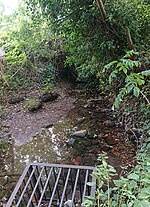Wightwick Manor

The legacy of a family's passion for Victorian art and design, Wightwick Manor (pronounced "Wittick") is a Victorian manor house located on Wightwick Bank, Wolverhampton, West Midlands, England. Owned by the National Trust since 1937, the Manor and its grounds are open to the public. It is one of only a few surviving examples of a house built and furnished under the influence of the Aesthetic movement and Arts and Crafts movement. The house is in a grand version of the half-timbered vernacular style, of which the most famous original example is Little Moreton Hall over 40 miles to the north, in Cheshire (also National Trust). The house is a notable example of the influence of William Morris, with original Morris wallpapers and fabrics, De Morgan tiles, Kempe glass and Pre-Raphaelite works of art, including works by Dante Gabriel Rossetti, Evelyn De Morgan, Edward Burne-Jones, Ford Madox Brown, John Everett Millais, Elizabeth Siddal and Leonard Shuffrey.
Excerpt from the Wikipedia article Wightwick Manor (License: CC BY-SA 3.0, Authors, Images).Wightwick Manor
Quail Green, Wolverhampton Castlecroft
Geographical coordinates (GPS) Address External links Nearby Places Show on map
Geographical coordinates (GPS)
| Latitude | Longitude |
|---|---|
| N 52.5834 ° | E -2.1944 ° |
Address
Wightwick Manor Gardens
Quail Green
WV6 8DF Wolverhampton, Castlecroft
England, United Kingdom
Open on Google Maps





